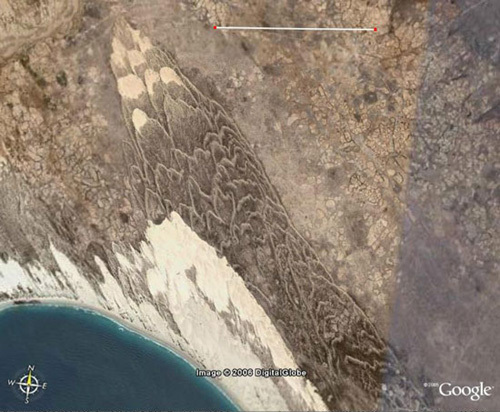Could a Comet Have Caused the Great Flood?
Earlier this century, satellite images made by Landsat 7 revealed four chevron-shaped land features on the southwest coast of Madagascar, 180 meters high and up to 5 kilometers inland .
The striking scenery, formed by enormous wedge-shaped sediment deposits called chevrons, has been hypothesized as providing evidence of a "megatsunami," caused by a celestial object crashing into the Indian Ocean. The chevrons seem to point to a feature called the Burckle crater, that lies in deep ocean about 1.700 kilometers east-southeast of the Madagascar chevrons. This is thought to be the impact crater, and is estimated to be 4.800 years old. The chevrons in Madagascar are filled with melted microfossils from the bottom of the ocean, but decisive evidence in the form of layers of glassy droplets and fused rock in sea-core samples has not been found yet.
The impact of the huge comet or asteroid must have been a catastrophic event. It would have sent a series of 200-meter-high tsunamis crashing against the coastlines and injected plumes of superheated water vapor and aerosol particulates into the atmosphere. For about a week, material ejected into the atmosphere would have plunged the world into darkness.
What's interesting is that legends about a Great Flood are known to almost every culture in the world. The Bible tells the story of Noah's Ark which describes a deluge for 40 days and 40 nights that created a flood so great that Noah was stuck in his ark for two weeks until the water subsided. This story from the Book of Genesis must have been based on the Sumerian "Gilgamesh Epic" in which King Gilgamesh, the hero of Mesopotamia, saw a pillar of black smoke on the horizon before the sky went dark for a week and "six days and 6 nights blows the flood wind, as south-storm sweeps the land."
The Epic of Gilgamesh story speaks of taking the seeds of every living thing into a boat. This constitutes a difference with the Biblical account of Noah, but makes much more sense. Obviously, the wheat cultivating Babylonians wanted to save their seeds so that they could start cultivating their land again after the flood.
Myths recounted in the Pacific and indigenous South American cultures also tell of a great flood. All those stories have some elements in common: a boat should be loaded with living material, when it finally hit land again some sort of bird is sent, and afterwards a sacrifice is made to the gods. As far as can be ascertained, the dates given by the various myths point to a period around 3000 BC.
After studying 175 flood myths from around the world, archaeologist Bruce Masse found two stories of particular interest. A Hindu myth describes an alignment of the five bright planets that has happened only once in the last 5.000 years, and a Chinese story mentions that the great flood occurred at the end of the reign of Empress Nu Wa. Cross-checking historical records with astronomical data, Masse came up with a date for the event: May 10, 2807 BC.
Many people at that time must have lost their lives due to the disastrous events. The floodmyths usually put the blame for all this on a race of people called "Giants." In the Bible it says: "The sons of God came in to the daughters of men, and they bore children to them. Those were the mighty men who were of old, men of renown" (Genesis 6-4).
They might refer to an ancient culture of fairly tall people with a highly developed civilization who were therefore considered to be giants both physically, as well as intellectually and spiritually. The "Book of Enoch," an ancient Jewish religious work that is not part of the biblical canon, gives some more details about the Giants. According to Enoch, they were the fruit of interbreeding of the "watchers" or "fallen angels with women, and thus became half man half god. They were punished with the Great Flood for having knowledge of astronomy, metallurgy, arms, the weather and also herbs and root cutting, which indicates the use of Ayahuasca or other types of hallucinogenic drugs.
A connection has been suggested between the Giants and the spread of Indo-European languages. Today, the Indo-European language group ranges from Hindi and Persian to Germanic, Latin and Slav languages like English, Spanish and Russian. In their various mythologies, from Hindu myths to Norwegian sagas, striking similarities are present as well.
They seem to originate from a nomadic people, that lived north of the Black Sea in what's now known as Ukraine some 6.000 years ago. They are known for building Kurgans (burial mounds) and were the first to domesticate horses. They are believed to have invented the wheel, although this is not quite certain. In any case, they were skilled horse- and chariot drivers and, as as is shown by the length of their West-European descendants , they must have been rather tall. Whether they were the ones who had to be punished for their pride with a Great Flood remains speculation of course, but it is an interesting thought.
Climatological and geological data show that there have been many major floods in the past and proof of a Biblical flood is very hard to find. How the story of the Great Flood spread itself around the whole world is also unknown, but the amount of worldwide trade and cultural interaction that went on in ancient times could be seriously underestimated. Compare it to pizza: everybody all over the world likes it but that doesn't mean we all descended from Italians.
(January 2016)

Chevrons in Madagascar
